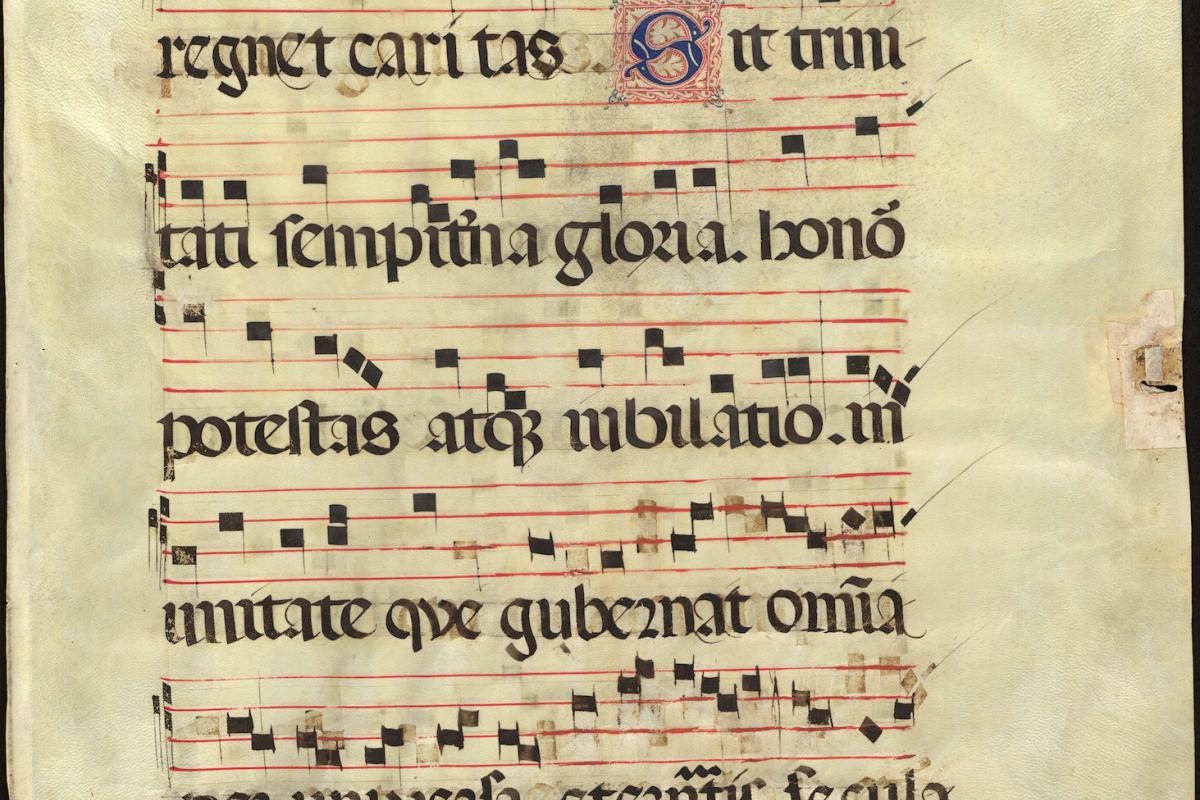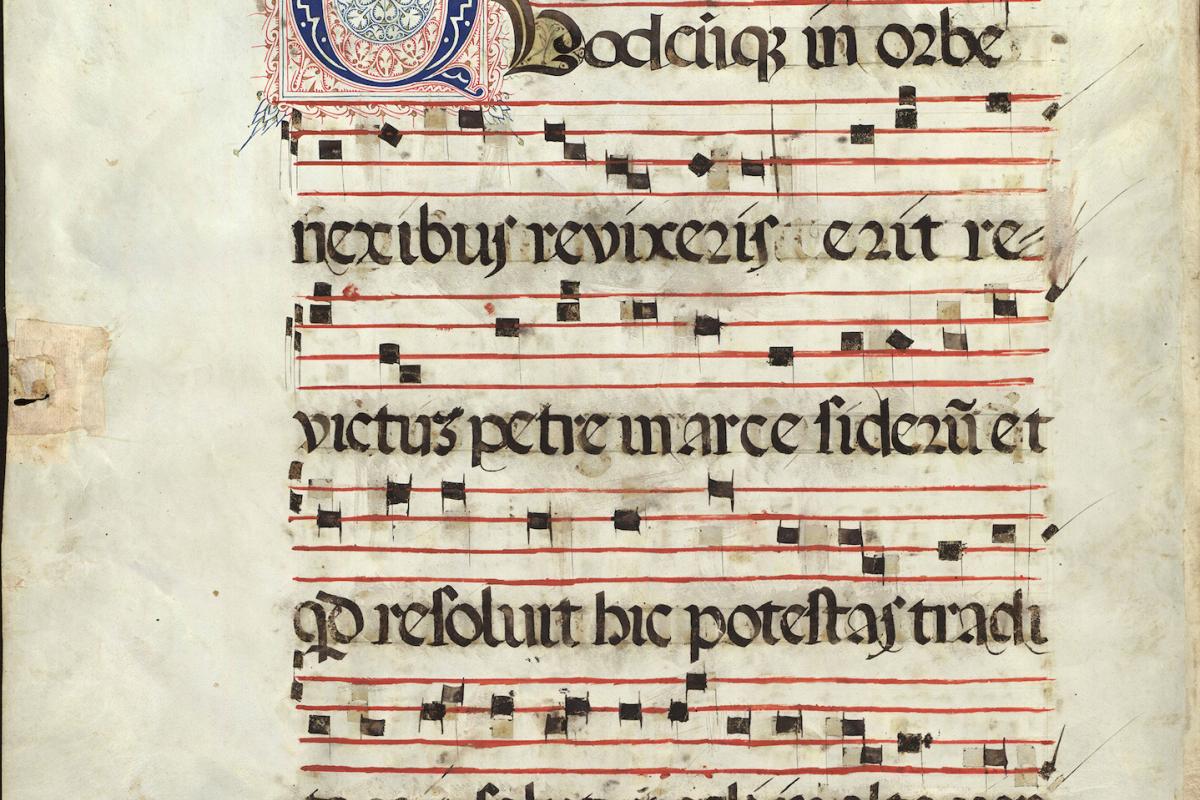Antiphonal Leaf for the Feast of the Chair of Saint Peter
Antiphonal Leaf for the Feast of the Chair of Saint Peter
Italian, 15th century
Single leaf
ink on vellum
height 62 cm
Portland State University Library Special Collections
Mss. 18, Rose-Wright Manuscript Collection no. 10
Music in the Middle Ages: Two Antiphonal Leaves
A description of two antiphonal leaves housed in the Millar Library Special Collections of Portland State University in Portland, Oregon. This video was made as part of the 2011 Medieval Portland Capstone taught by Professor Anne McClanan for the University Studies program.
Christopher Brummer and April Perrine, Medieval Portland Capstone, 2011
Object #18 in the Portland State University Millar Library Special Collections is an antiphonal leaf written with ink on vellum. Antiphonals, or antiphonaries, are books containing the lyrics to the parts of the divine office, a series of chants, prayers, and hymns sung by monastic and church communities every day at specific hours (Brown 11-12).
Antiphonals are often larger in size than other contemporaneous manuscripts; they needed to be seen and read from a distance by multiple singers simultaneously. The larger dimensions of antiphonals provided space for larger lettering, which made distance reading possible. This antiphonal leaf measures 45cm by 61cm and is numbered as being pages 235 and 236 of the full volume to which it once belonged. The large size of the piece also specifies a time frame as chant books of the fifteenth century grew larger in proportion, to an average size of 42x29 cm (Bell 45). Our manuscript is even larger at 62 cm. Again, there is validation in dating the manuscript to sometime within the fifteenth century.
The text records lyrics for a hymn to St. Peter sung for vespers or evening prayers, for the Feast of the Chair of Saint Peter. It is from the second Vespers from a section of the Roman Catholic Breviary. The Breviary as we understand it today is " a book containing the entire canonical office" (Carol). It is from the section known as the "Proper of the Saints," and is from the Ambrosian "Sanctorale" calendar. This type of calendar contains the feasts of saints and is fixed to certain days throughout the year. The "Temporale" calendar contains feasts that are moveable, depending upon the calculation of Easter (Fassler 15).
The Feast of the Chair of St. Peter was celebrated on either January 18th or in its present-day (ninth century) form on February 22nd. It celebrates the day St. Peter first sat as head of the Catholic Church. It was celebrated at both the Vatican Basilica and the cemetery at the Via Salaria. February was especially an important date because it was "considered the anniversary of the day when Peter bore witness...to the Divinity of Christ and was again appointed by Christ to be the Rock of His Church" (Waal). This is usually the day that it is celebrated in modern times, although the modern Liber Usualis places its information on January 18th.
This feast is considered a "lesser feast." This means that if there were a more important feast from the Temporale calendar that fell on the same day, it would bump the Chair of St. Peter and replace it. Along with the feast of St. Bartholomew, the feast of the chair of St. Peter was not celebrated officially prior to the eleventh century, and "only in the thirteenth century is an Office provided, but then the chants needed at Vespers and Matins (no Vigils are indicated) were simply borrowed from the feast of SS. Peter and Paul" (Fassler 265). However, there are some that suggest that while there was no official celebration, the feast can be dated as far back as the third or fourth century (Waal).
Even though it was a later addition to the breviary, our particular feast was not given any new material for its celebration. This is also reinforced in its psalms: The psalms chosen are numbers 46 and 138. These are not proper psalms at all, but rather the Vesper psalms of the Common Office of Apostles. The antiphons assigned to [this feast], Tu es pastor, and Petre Amas me, contain no reference to the psalms they accompany (Fassler 265).
Our manuscript does not appear to contain words that include either choice, although it is possible that the antiphon is not concluded by the end of folio 235. Or it is possible that this particular antiphon changed sometime after its introduction in the thirteenth century. Perhaps it was finally given its own personalized wording and hymns. This personalization would certainly highlight our manuscript as it is. Perhaps the older text underneath is the original "borrowed" hymns and antiphons from the feast of Saints Peter and Paul, and the new words are a part of the modern-day form that we see today. Or it is possible that this text was simply thrown together on an old piece of parchment so that this particular feast, though not overly important within the Sanctorale calendar, could be added to an existing breviary.
All text records a form of late Medieval Latin in a script matching the "littera gothica textualis rotunda italiana formata," or roughly "Gothic letters of text (with) round Italian form" ("Remains of a Medieval Italian Antiphonal"). The style can be quickly identified in two ways: by the uniform strokes comprising standard letters that do not break their head- or baselines; and the strict rules providing only certain letters, called 'extenders,' to extend beyond the head- and baselines, such as 's' and 'p' ("Remains of a Medieval Italian Antiphonal").
This style is consistent with the cataloging information that states this manuscript is Italian in origin: "in Spain and Italy, rigidly angular Gothic Scripts were largely avoided... Rotunda [Gothic] was widely used, in tiny Books of Hours and in gargantuan manuscripts for liturgical use, often with musical notation" (Knight F1). Gothic was a style used throughout Europe in the thirteenth and fourteenth centuries. Paleographers note, however, that "the Italian types such as Rotunda are forms less typical of Gothic scripts... less angular and spiky, more rounded" (Derolez 4). The Rotunda form, then, is somewhat specific to the Italian region during the later medieval period. In this case, we can trust that the manuscript is Italian in origin.
There is much evidence of erasure and overwriting of the text; faint neumes can be seen on the staff corresponding to later, darker neumes; outlines and washed script can be found underneath and between the spacing of individual letters and words in the lines of text. Because these traces of erasure and overwriting are abundant on every staff and line, this vellum page was likely reused and not simply corrected by the recording scribe.
Above each line of text or lyric is accompanying musical notation. The notation follows the system known as 'square notation' and features a staff of four red lines with Gothic neumes or notes recorded in short, black/brown bars (Bell 26-27). Given the style of notation, this piece was likely intended for unaccompanied singing or plainchant (11-12). That the neumes are written in square form is consistent with its dating. But it is also important to remember that square notation was well established prior to the fifteenth century and remained for some time after. In the fourteenth century, a shift began within music that changed its focus. Music was included in university curriculums and was grouped together with subjects like mathematics and astronomy. However, music remained an important part of ecclesiastical services.
These dual focal points led to increasing complexities within music theory. These complexities included several aspects of music theory; i.e., harmony, melody, point-counterpoint arrangements, and rhythm (all aspects of polyphonic music). By the fourteenth century "the interest already found in music as a technical toy became, by the end of the century in France, the overriding concern" (Seay 127). This shift towards the technical created what music historians refer to as the "Ars Nova." While it began in France, similar shifts occurred in England and Italy.
Polyphonic music of the Italian Ars Nova was somewhat skewed in that almost all "examples of Italian polyphony are nearly all secular works•this emphasis on the secular as the place of polyphony is a general characteristic of the Italian Ars Nova" (Seay 150). Therefore, this manuscript's simplicity within its musical notation does not necessarily exclude it from its time period. More research from a medieval music expert would be needed to ascertain an accurate timeframe.
According to the cataloging information, the beginning words on folio 236, "na secula" are left over from the earlier text. "Quodcumque" is a hymn, so the actual Vespers response is before that, on folio 235 with the words "Sit trinitati." Also, despite searching several medieval music databases, there are no records of the "Quodcumque" hymn as it is represented in this manuscript. Most of the hymns that are associated with this particular festival are written as, "quodcum que ligaveris super terra erit ligatum..." A search through the feasts of SS. Peter and Paul did not reveal any similarities either. Thus, a close examination of the style, materials, and subject matter of the Millar Library's Antiphonal Leaf offers scholars valuable insight into Italian Renaissance musical, liturgical, and scribal history.
Bibliography
Bell, Nicholas. Music in Medieval Manuscripts. Toronto: University of Toronto Press, 2001. Bischoff, Bernhard. Latin Paleography: Antiquity and the Middle Ages. Translated by Daibhi O. Croinin and David Ganz. Cambridge: Cambridge University Press in association with The Medieval Academy of Ireland, 1990.
Brown, Michelle. Understanding Illuminated Manuscripts: a guide to technical terms. Malibu, California: J. Paul Getty Museum in association with the British Library, 1994. Brown University. "Remains of a Medieval Italian Antiphonal." Last modified August 18, 2009. http://www.brown.edu/Facilities/University_Library/libs/hay/ focus/ antiphonals/.
Cabrol, Fernand. "Breviary." The Catholic Encyclopedia. New York: Robert Appleton Company, 1908. 26 June 2008 http://www.newadvent.org/cathen/02768b.htm.
Clemens, Raymond, and Timothy Graham. Introduction to Manuscript Studies. Ithaca and London: Cornell University Press, 2007.
Derolez, Albert. "The Script Reform of Petrarch: An Illusion?" Haines, John, Randall Rosenfeld, ed. Music and Medieval Manuscripts: Paleography and Performance. Burlington: Ashgate, 2004.
Fassler, Margot E., and Rebecca A. Baltzer, eds. The Divine Office in the Late Middle Ages: Methodology and Source Studies, Regional Developments, Hagiography. New York: Oxford University Press, 2000.
Haines, John, and Randall Rosenfeld, eds. Music and Medieval Manuscripts: Paleography and Performance. Burlington, Vermont: Ashgate Publishing Company, 2004.
Heffernan, Thomas J., and E. Ann Matter, eds. The Liturgy of the Medieval Church. Kalamazoo, Michigan: Medieval Institute of Western Michigan University, 2001.
Johnston, Harold W. Latin Manuscripts. Chicago: Scott, Foresman & Company, 1897.
Knight, Stan. Historical Scripts: A Handbook for Calligraphers. London: A&C Black LTD, 1984.
Parrish, Carl. The Notation of Medieval Music. New York: Pendragon, 1978.
Leech-Wilkinson, Daniel. The Modern Invention of Medieval Music: Scholarship, Ideology, Performance. Cambridge: Cambridge University Press, 2002.
Manion, Margaret M., and Bernard J. Muir, eds. The Art of the Book: Its Place in Medieval Worship. Exeter, Devon, UK: University of Exeter Press, 1998.
Seay, Albert. Music in the Medieval World. Englewood Cliffs: Prentice-Hall, 1965.
Sticca, Sandro, ed. Saints: Studies in Hagiography. Binghamton, New York: Center for Medieval and Early Renaissance Studies State University of New York at Binghamton, 1996.
Taylor, Robert A., James F. Burke, Patricia J. Eberle, Ian Lancashire, and Brian S. Merrilees, eds. The Centre and its Compass. Kalamazoo, Michigan: Medieval Institute of Western Michigan University, 1993.
Waal, Anton de. "Chair of Peter." The Catholic Encyclopedia. Vol. 3. New York: Robert Appleton Company, 1908. 26 June 2008 http://www.newadvent.org/cathen/03551e.htm."




